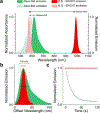Harnessing nanotechnology to expand the toolbox of chemical biology
- PMID: 33414556
- PMCID: PMC8288144
- DOI: 10.1038/s41589-020-00690-6
Harnessing nanotechnology to expand the toolbox of chemical biology
Abstract
Although nanotechnology often addresses biomedical needs, nanoscale tools can also facilitate broad biological discovery. Nanoscale delivery, imaging, biosensing, and bioreactor technologies may address unmet questions at the interface between chemistry and biology. Currently, many chemical biologists do not include nanomaterials in their toolbox, and few investigators develop nanomaterials in the context of chemical tools to answer biological questions. We reason that the two fields are ripe with opportunity for greater synergy. Nanotechnologies can expand the utility of chemical tools in the hands of chemical biologists, for example, through controlled delivery of reactive and/or toxic compounds or signal-binding events of small molecules in living systems. Conversely, chemical biologists can work with nanotechnologists to address challenging biological questions that are inaccessible to both communities. This Perspective aims to introduce the chemical biology community to nanotechnologies that may expand their methodologies while inspiring nanotechnologists to address questions relevant to chemical biology.
Conflict of interest statement
Competing Interests
D.A.H. is a cofounder and officer with equity interest in Goldilocks Therapeutics, Inc., LipidSense, Inc., and Nirova BioSense, Inc. D.A.H. is a member of the scientific advisory boards of Concarlo Holdings, LLC and Nanorobotics, Inc. R.M.W. is a scientific advisor with equity interest in Goldilocks Therapeutics, Inc. M.L. is a member of the scientific advisory board of Epi One, Inc. P.V.J. is a cofounder and officer with equity interest in LipidSense, Inc. and an officer of Nirova BioSense, Inc.
Figures






References
Publication types
MeSH terms
Substances
Grants and funding
LinkOut - more resources
Full Text Sources
Other Literature Sources

